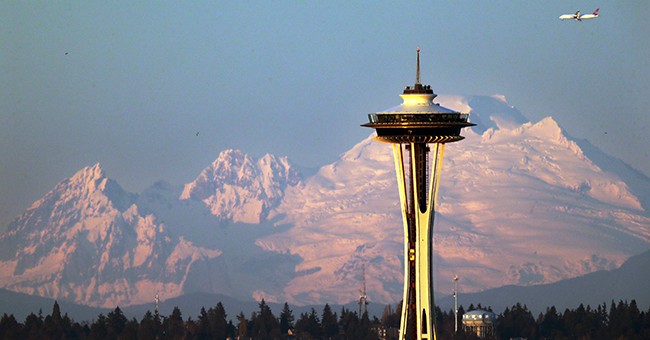In a matter of days, millions of Americans have been asked to do what might have been unthinkable only a month ago: Don't go to work, don't go to school, don't go to church, don't leave your house, unless you have to.
Seattle was ground zero for the coronavirus in America, claiming 37 of its first 50 victims.
Now, there's a ray of hope. Maybe. In Seattle. And beyond.
Be informed
Guy Benson wrote an article for Town Hall that caught my attention, titled "Hope: Is hard-hit Seattle flattening its coronavirus curve?"
Benson says,
"Clearly concerned about citizens growing complacent after learning about positive developments, Gov. Jay Inslee is quoted as saying the state is not 'within 1,000 miles' of declaring victory. The governor said that the state was far from turning a corner. While there are indications of improvement, he said, he has also seen numbers in the last few days that still have him worried, including a rise in positive test results statewide and the emergence of new cases in rural areas."
Several questions come to mind.
#1. Are these aggressive social distancing policies working?
According to a New York Times article, they appear to be bending the trajectory in a less destructive direction.
The Times published this on March 29:
SEATTLE — The Seattle area, home of the first known coronavirus case in the United States and the place where the virus claimed 37 of its first 50 victims, is now seeing evidence that strict containment strategies, imposed in the earliest days of the outbreak, are beginning to pay off — at least for now.
Deaths are not rising as fast as they are in other states. Dramatic declines in street traffic show that people are staying home. Hospitals have so far not been overwhelmed. And preliminary statistical models provided to public officials in Washington State suggest that the spread of the virus has slowed in the Seattle area in recent days.
While each infected person was spreading the virus to an average of 2.7 other people earlier in March, that number appears to have dropped, with one projection suggesting that it was now down to 1.4.
The researchers who are preparing the latest projections, led by the Institute for Disease Modeling, a private research group in Bellevue, Wash., have been watching a variety of data points since the onset of the outbreak. They include tens of thousands of coronavirus test results, deaths, and mobility information — including traffic patterns and the movements of anonymous Facebook users — to estimate the rate at which coronavirus patients are spreading the disease to others.
The progress is precarious, and the data, which was still being analyzed and has yet to be published, is uncertain. Officials said that expansive social distancing policies will remain a key part of daily life for weeks to come.
But the findings offer a measure of hope that the emergency measures that have disrupted life in much of the nation can be effective in slowing the spread of the disease.
#2 What about other cities and states? Is there hope?
The New York Times said on March 31, "There are at least 270 million people in at least 33 states, 89 counties, 29 cities, the District of Columbia and Puerto Rico who are being urged to stay home."
The Times published a very informative map that shows all the states, with a brief breakdown of the numbers of cases and other pertinent information. It's dynamic and is updated daily.
Based on the scientific data, it appears that there is reason for hope. Maybe.
President Trump said at his daily news briefing Tuesday, the next two weeks are "going to be rough, really rough, but there's reason for hope. We're going to get through this."
Samuel Heilman is a Jew who lives in the New Rochelle area of New York, now the hardest hit area, whose family was among those who were ordered to self-quarantine at home.
Samuel says, "In the beginning, it felt like we were being punished, but the punishment turned out to be a blessing in disguise. It's all a matter of perspective"
#3 Why?
Speaking of perspective, another Jew once wrote,
"Why are you cast down O my soul, and why are you in turmoil within me? Hope in God; for I shall again praise Him, my salvation" (Ps. 42:5).
Who is God to you?
Charles Spurgeon once said,
"Without Christ, there is no hope." He makes a great point. If Christ is not the anchor of our life, what is? Everything that can be, is being shaken today. Why would He not be? Great Christian leaders from Apostle Paul in the New Testament to contemporaries today have carefully explained the path to hope is the path to God. Jesus, said "I am the way" and He said "there is no other way to God than through me."
Paul explained the path to hope in Romans 10:9, "If you confess with your mouth the Lord Jesus and believe in your heart that God has raised Him from the dead, you will be saved."
Why would we not do that, especially when everything in our world is being shaken?
Catherine Marshall said, "God is the only one who can make the valley of trouble a door of hope."
Why would we not walk through that door?
For those who have walked through that door, Corrie Ten Boom said: "Never be afraid to trust an unknown future to a known God."
Yes, there's reason for hope in Seattle, and New York and America, and the world.
And for you.
Be Informed. Be Hopeful. Be Prayerful. Be Blessed.


